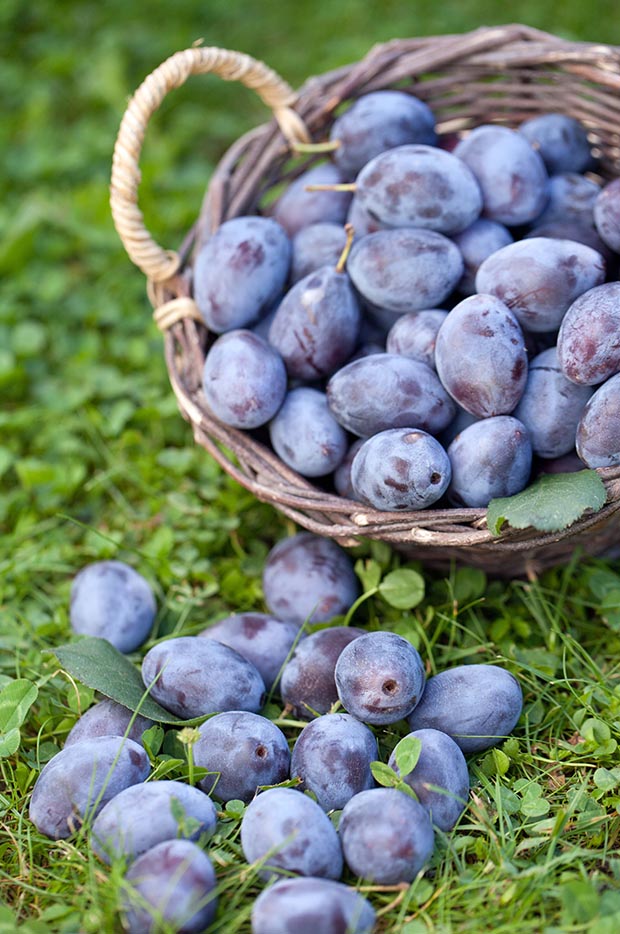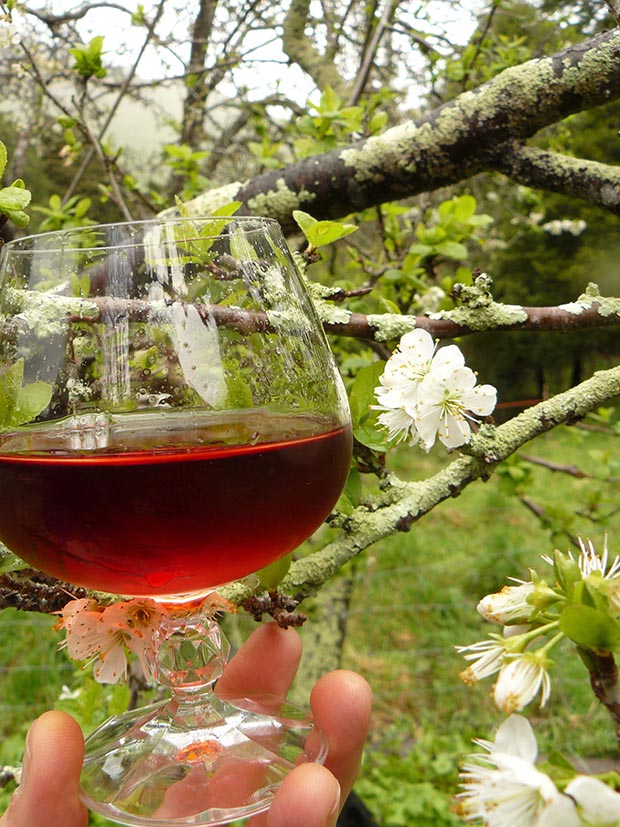6 reasons to grow sweet little damson plums and how to make damson gin

It’s a funny-looking cousin of the plum, and it can tarten up your gin too.
Words: Kristina Jensen
It’s a good idea to take a break. Unfortunately, there has been one kind of break at our place that we’re not so happy about. The kind that wipes out half the damson plum tree in a winter gale.
We are pretty sad about this tough little tree. Closer inspection showed one of the main trunks that broke off at ground level had long cracks running vertically down the bark. Thanks to a very wet 2017, it was clear that lots and lots of water had been running down into those cracks, causing a slow and devastating rot.
According to one local source, our little tree is possibly over 50 years old. For the past four years, it had produced in excess of 30kg of tarty fruit each year. We have frozen most of it, turning it into damson gin, damson plum jam, and various kinds of chutneys and sauces.
When these small dusky purple globes finally get a bit of sweetness in them late in the season, we eat them straight off the tree but by then we are competing with the birds. Untold seedlings pop up underneath it. I hear that damsons take a long time to fruit, but I still pot them up and plant them out in secretive spots along the roadside in the hope that they will survive uprooting by weka and pigs or death by munching from deer and kererū.
Damsons (Prunus domestica insititia) are archaically called the ‘damascene’ which alludes to their origin in Syria. It seems that the Romans took damsons to England and the English took them around the world. For a plum that apparently originated in a hot dry climate, it does surprisingly well in wet and windy climes. We suspect our tree has succumbed mostly to old age with its cracks and breaks.
Many people herald the damson as the ultimate easy-care tree:
• it’s small;
• it fruits pretty much every year;
• it doesn’t need much pruning;
• it has very few pests
• it is self-fertile so you only need one tree.
Damsons are often overshadowed by their larger sweeter plum cousins. They the kind of fruit that you need to know about to know what to do with them because if you eat a fresh one, you will be instantly put off by the slightly bitter, astringent flavour.
However, whip up a batch of damson jam and I guarantee you will be sold. I have a neighbour who adores my version of damson jam. I keep her in a steady supply and in return I score green goodies from her wonderful self-seeding vegetable patch. The secret is to preserve that tartness so I use a jam setting sachet (available at supermarkets) that reduces the sugar content by half. Two kilos of plums, one kilo of sugar and one sachet. Easy.
The big job is dealing with the stones. Some people say leave them in. One person even suggested that having to spit out the stones in the morning while you eat your toast helps to wake you up. I prefer to roll up my sleeves: I boil the fruit until it’s tender, let it cool, then sit down with a sieve and a bowl and carefully squish the flesh out, removing the stones as I go.

I really like the skin in my jam too so I actually take the stones out of the sieve and then transfer the skins which are left behind back into the jam pot.
This kind of jam is a labour of love. It’s also a good moment to meditate, reflect and let your thoughts drift. Until I forget what my hands are doing and realize that I’ve just put a bunch of pips back into the jam pot.
Damson Gin
Ready in: 3 months
Makes: 500ml
Damson gin is dead easy to make and a summer’s end ritual for our family. Some folks use vodka but I can’t stomach the stuff so my chosen spirit is gin. After the little plums have had a good long soak, you’ll end up with a wonderfully rich, ruby liquid infused with the tartness of the plums and the sweetness of as much sugar as you want to add. This recipe fills one Agee jar. Clip top jars are also ideal for this purpose.
INGREDIENTS
450-500g fresh or frozen damson plums
50-200g sugar (depending on how sweet a tooth you have)
350ml gin or vodka
METHOD
To sterilise your jars, wash and rinse them, place in the oven for 10 minutes at 180°C, then take out to cool. Wash the damson plums and pull off any stalks and leaves. Prick a few holes in each one with a skewer or large needle. NB: if you are using frozen plums, you can omit this step as the skins split open from being frozen. Pop the plums into the jar(s) and add your chosen quantity of sugar.
Add gin or vodka, shake until you’ve soaked the sugar with alcohol and store in a dark place (the darkness preserves the colour of the plums). Swill fruit around, inverting the jar completely, once a day for 7-10 days, until all the sugar has dissolved, then occasionally for the next three months.
When three months are up, strain and bottle. You can sip your damson gin straight or mix it with tonic water, lemon and ice for a refreshing summer nip.
DAMSON GIN TIPS
1. Keep your empty gin bottle to decant your damson gin back into the bottle.
2. Don’t throw the fruit away, if you have used fresh plums. You will end up with a bunch of divine tasting shrivelled up little jewels that you can either eat as they are, or de-stone and use them to make plum puddings or Christmas cake. They can be dried in the oven on a low temperature but who wants to lose all that alcohol?
3. The whole plums can be dipped in chocolate that has been poured into ice cube trays to make decadent damson gin chocolates.
4. If you have used frozen plums, you are more likely to end up with more of a plum paste. This can be kept in the fridge and added to cakes, cheesecakes, smoothies, crumbles and yoghurt for an out-of-this-world alcoholic plummy hit.
Kristina Jensen lives in the beautiful Marlborough Sounds. She sidesteps supermarkets, gardens madly, and loves to make anything and everything herself.


